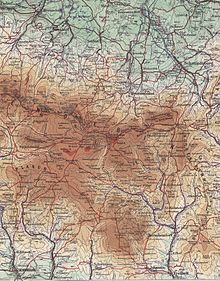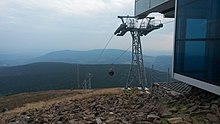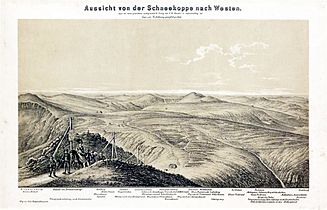Schneekoppe
| Sněžka / Śnieżka | ||
|---|---|---|
|
Schneekoppe from west-north-west; in front of it the Schlesierhaus |
||
| height | 1603.2 m nm | |
| location | Border Královéhradecký kraj , Czech Republic / Lower Silesian Voivodeship , Poland | |
| Mountains | Giant Mountains | |
| Dominance | 290 km → Malý Kriváň ( Little Fatra ) | |
| Notch height | 1193 m ↓ Treuchtlingen-Graben | |
| Coordinates | 50 ° 44 '10 " N , 15 ° 44' 23" E | |
|
|
||
| rock | granite | |
| Development | Construction of the Laurentius Chapel 1665–1681 | |
The Schneekoppe ( Sněžka in Czech , Śnieżka in Polish , also called Riesenkoppe or just Koppe ) is the highest point in the Giant Mountains at 1603.2 m nm . It is the highest mountain in the Sudetes , the Central European Central Uplands and the Czech Republic . The border of Poland along the Lower Silesian Voivodeship and the Czech Republic along the Hradec Králové region runs over the mountain top .
geography
location
The Schneekoppe is located in the central part of the Giant Mountains on its main ridge - on the Východní Slezský hřbet (Eastern Silesian Ridge) . The border between the Czech Republic and Poland runs across its summit. South of the mountain in the Czech region of Královéhradecký is the town of Pec pod Sněžkou (Petzer) and to the north in the Polish Voivodeship of Lower Silesia the town of Karpacz (Krummhübel) .
South of the Úpa flows the Úpa (Aupa) , which rises on the Równia pod Śnieżką (Koppenplan) west of the mountain, runs through Pec pod Sněžkou and flows into the Elbe . To the north runs the Łomnica (Great Lomnica) , which rises on the same plateau, flows through Karpacz and flows into the Bóbr (Bober) .
The neighboring mountains of the Schneekoppe on the Czech-Polish border are the Svorová hora ( 1410.6 m nm ; German Black Koppe ; pol. Czarna Kopa ) in the east and the Smogornia ( 1488.6 m npm ; German Mittagsberg ; Czech Stříbrný hřbet ) in the northwest. To the south the landscape leads over a ridge to the Czech Růžová hora ( 1393.1 m nm ; Rosenberg ). In the north-north-west lies the Polish Kopa ( 1377.4 m npm ; Kleine Koppe ) beyond the headwaters of the Łomnica near the source .
summit
The summit of the Snow Mountain located on the border is located above the to about 1200 m NPM located height timber line . It is developed for tourism and is a destination for many visitors, especially in the summer months. The Laurentius Chapel stands on the summit . On the Czech side there is the Czech post office on the Schneekoppe and the summit station of the gondola lift starting in Pec pod Sněžkou and on the Polish side the futuristic looking mountain hut, which was built from 1969 to 1974.
climate
The climate and vegetation in the high altitudes of the Giant Mountains are described as alpine , although the corresponding altitude is not reached. The average annual temperature on the Schneekoppe is 0.2 ° C. At the tree line at around 1200 m npm , the spruce forest loses its height and density, and it turns into knee wood. This zone, called subalpine, extends to an altitude of 1450 m npm .


history
The first verifiable summit ascents were carried out in the middle of the 15th century. In 1456 a Venetian merchant climbed the summit in search of precious stones . The baroque Laurentius Chapel on the summit was donated by Count Leopold von Schaffgotsch in 1668–1681 and inaugurated by Abbot Bernhard Rosa from Grüssau . Five times a year held there, the monks from the provost Warmbrunn services from. After the secularization in 1810, the chapel was profaned as a hostel in 1824. When the hostel was no longer able to cope with the growing stream of tourists and the first guest house was built on the summit, the chapel was restored and rededicated in 1850. Thereafter, services were held annually on the name day of the patron saint St. Laurentius . After the inn was destroyed by arson in 1857 and by lightning in 1862 , it had to be completely rebuilt. In 1868 an inn was also built on the Bohemian side. (see article: Bohemian and Prussian Baude )
In 1800 Friedrich Wilhelm III. (Prussia) and Luise von Mecklenburg-Strelitz the mountain. In 1804, the later US President John Quincy Adams published a travelogue about Silesia, including the ascent of the Riesenkoppe .
In 1828 the Warsaw student Józef Odrowąż -Pieniążek had an accident on a trip to Śnieżka. A historical plaque written in Polish in the Laurentius Chapel commemorates this event.
At the end of 1899, Prussia set up the highest weather station north of the Danube on the summit, which was opened on July 5, 1900. The observer's apartment was on the ground floor, the duty rooms on the first floor and an observatory above. Until 1945 the Schneekoppe was the highest mountain in Prussia and the German low mountain range . At the turn of the century around 1900, a post office was built on the summit . In 1907 alone, 12,000 postcards with special postmarks were sent all over the world.
Buildings on the top
The Kaplica świętego Wawrzyńca na Śnieżce (German: St. Laurentius Chapel , Czech: Kaple svatého Vavřince ) is the oldest building. It is 14 m high and is located on the Polish side.
The new Czech post office was built in 2006 and opened in 2007 by President Václav Klaus .
The observatory and restaurant on the Polish side, in Czech Polská bouda (gastronomy, weather station, observatory), has the shape of "flying saucers" and was designed by the Polish architects Witold Lipiński and Waldemar Wawrzyniak at the University of Wroclaw . The buildings were built between 1964 and 1974. In March 2009 the Polish weather station and the Polská bouda were badly damaged by the weather and were later repaired.
Cable car
Tourism took off again after the Second World War . Ascent aids were built to overcome the considerable height difference between the surrounding tourist resorts and the mountain ridge . On the Czechoslovak side, a Von Roll single-cable chairlift led to the summit. Two people sat side by side in the armchairs of this train, across the direction of travel. The railway led from the northern edge of the place Pec pod Sněžkou ( 890 m nm ) over the Růžová hora ( 1354 m nm ) up to Sněžka ( 1594 m nm ). Construction of the cable car began in 1946; the cost was 4.796.900 Kcs . estimated. The lower part was opened on January 15, 1949, the upper part with test runs on November 10, 1949. The upper part of the track caused difficulties due to strong weather conditions. In the winter of 1962/63, operations were interrupted due to icing, and in 1968 it crashed Train a. Originally a 17-year-old operation was planned, in 1980 the operation was temporarily stopped after 30 years. It was not until 1982 that the cable car system went back into operation after the worst safety deficiencies had been rectified.
Initially, the cable car belonged to the Czechoslovak State Railways , only in 1997 it went to Pec and Malá Úpa , since 1999 it has belonged to the city of Pec alone.
Since the beginning of the 1990s, the Czech national park administration has repeatedly called for the outdated facility to be demolished without replacement in order to limit the number of visitors in the ecologically sensitive area around the Schneekoppe. In June 2007 it was decided to build a new cable car on the same route.
The foundation stone was laid for the new construction of the lift on September 22, 2011, and construction work began in July 2012. The upper section of the old lift had been out of service since May 13, 2012, and the lower section followed on September 2, 2012.
The new cable car was supplied by Leitner AG . It is a monocable orbit. The cabins are pre-accelerated with friction wheels and then attached to the rope before they leave the stations. They can accommodate four people.
Like the chairlift, the railway runs in two sections from Pec pod Sněžkou ( 829 m nm ) via Růžová hora ( 1339 m nm ) up to Sněžka ( 1588 m nm ). The Růžová hora and Sněžka stations built on the plans of the chairlift; the valley station in Pec pod Sněžkou, however, was built about 60 meters lower and thus closer to the place. The track is a total of 3716 meters long, the journey time is about 16 minutes (chairlift about 25 minutes). For reasons of nature conservation, the maximum transport capacity of the new lift remained the same as compared to the chairlift at 250 people per hour.
The new cable car went into operation in February 2014; the construction costs amounted to around 300 million crowns. The comparatively long construction time was due to the difficult weather conditions.
Paths to the summit
Marked paths lead to the main ridge and on via the friendship path to the Schneekoppe. The red ridge trail along the Polish-Czech border leads over the summit.
Czech side
- A gondola lift leads from Pec pod Sněžkou to the top. Since this leads up close to the ridge of the Riesengrund , you can see several 100 meters deep in places.
- From Pec pod Sněžkou the ascent is possible on foot via a blue marked path through the Obří důl .
- From Pec pod Sněžkou over the Růžová hora (Rosenberg) to Schneekoppe.
- From Velká Úpa (Großaupa) through the Šraml (Schrammen) over the Rosenberg (Růžová hora) .
- From Horní Malá Úpa (Ober-Kleinaupa) via Baude Jelenka (Emmaquellenbaude) to Schneekoppe.
- From Špindlerův Mlýn over the plan, the Vyrovka and Lucni Bouda
- From Špindlerův Mlýn via Sv. Petr. and the Kozi Hrbety
- From Špindlerův Mlýn along the white Elbe
- From the Spindlerovka Bouda along the Friendship Route
Polish side
- With the chairlift from Karpacz to the Kopa and then over the Schlesierhaus (Schronisko Dom Śląski) hike 225 meters in altitude to the Schneekoppen summit.
- A well-traveled path leads from Karpacz over the Melzergrund (Kocioł Łomniczki) and the Schlesierhaus (Dom Śląski) to the summit (difficult).
- From Brückenberg (Karpacz Górny) over the Teichbaude (Schronisko Samotnia) and the Hampelbaude (Schronisko Strzecha Akademicka) to the summit (easy).
- The chain-secured summit ascent between Schlesierhaus and Schneekoppengipfel is quite exposed, but it is also possible to climb the summit via the Jubiläumsweg (Droga Jubileuszowa) .
Panoramas
- “Views from the Schneekoppe to the four corners of the world.” Four lithographs from the middle of the 19th century by Ernst Wilhelm Knippel .
reception
When Heinrich von Kleist saw the sunrise from the summit of the Schneekoppe on his Silesian journey on July 13, 1799, he entered this incident in the summit book of the jumping hut and, inspired by Friedrich Schiller's Hymn to the Infinite , wrote a hymn to the sun , it begins with "Over the heads of the giants, high in the sea".
Eduard Becher's eight- stanza national anthem of Lower Silesia O, you home, dear and daring, dedicates a stanza to Schneekoppe:
- Where the heads are high and noble
- protrudes into the sea of clouds
- where the legend, world famous
- invented a Rübezahl -
- there you are, my Silesian country.
The mountain is named for the food manufacturer Schneekoppe , whose original company was founded in 1927 by Fritz Klein in a place at the foot of the Giant Mountains.
literature
- The wonder-full Schnee-Koppe, or description of the Silesian Giant Mountains. From the news of some people who have climbed this high mountain themselves. Leipzig 1736 ( digitized version ).
- Gerhard Eckert : The Schneekoppe. Rübezahl's summit, loved and unforgotten. Preußler, Nuremberg 1992, ISBN 3-925362-67-3 .
- Tomasz Przerwa: The Schneekoppe. The highest peak in the Giant Mountains. In: Marek Czapliński, Hans-Joachim Hahn, Tobias Weger (eds.): Silesian places of memory. Memory and Identity of a Central European Region. Neiße, Görlitz 2005, ISBN 3-934038-33-6 , pp. 7-11.
- Jürgen W. Schmidt: On the history of the weather station on the Schneekoppe. In: Specialized prose research - Crossing borders. Vol. 7, 2011, Baden-Baden 2012, pp. 351-370, ISSN 1863-6780 .
Web links
- Literature by and about Schneekoppe in the catalog of the German National Library
- High-resolution live webcam of the Schneekoppe
- Virtual show , virtualczech.cz
- C. Gentil: The chairlift to Schneekoppe (CZ) . Retrieved August 26, 2013 . (Documentation about the former Von Roll chairlift), on seilbahn-nostalgie.ch
Individual evidence
- ↑ a b Geoprohlížeč ČÚZK (topographic map), on geoportal.cuzk.cz
- ↑ Giant Mountains (Krkonoše) , on riesengebirgler.de
- ↑ Hugo Weczerka (Ed.): Handbook of historical sites . Volume: Silesia (= Kröner's pocket edition . Volume 316). Kröner, Stuttgart 1977, ISBN 3-520-31601-3 , p. 480.
- ↑ To the story of the day. In: Wiener Zeitung , October 30, 1857, p. 5 (online at ANNO ). Retrieved November 6, 2012
- ^ GDR calendar 1982
- ^ John Quincy Adams : Letters on Silesia: Written During a Tour Through that Country in the Years 1800, 1801 , London 1804, on books.google.com
- ↑ Journal Die Gartenlaube . Born in 1900, p. 296.
- ↑ Zpráva k projektu Nové České poštovny na vrcholu Sněžky , accessed on December 5, 2010, on snezka.net
- ↑ Stavba lanovky na Sněžku po letech dohadů začala , on novinky.cz
- ↑ Cable car: history and dates , on snezkalanovka.cz
- ↑ Cableway to Sněžka starts running ( Memento from April 15, 2014 in the Internet Archive )
- ↑ Construction of the new cable car on February 1, 2012 ( memento from February 10, 2013 in the web archive archive.today ), on snezkalanovka.cz
- ^ Hans Joachim Kreutzer : Heinrich von Kleist. CH Beck, Munich 2011, Schreibereien , p. 19; Poetry text based on Uli Schulte Döinghaus: Lower Silesian Sensations. In: Der Tagesspiegel . October 9, 2011. The beginning of the poem was the title of an exhibition about Kleist's Silesian journey in 2009, which also showed the summit book; Exhibition: Kleist manuscript for the first time in a German museum. In: Mitteldeutsche Zeitung . July 1, 2009.
- ↑ Text after O du Heimat lieb und traut (Heimatlied der Schlesier). In: Volksliederarchiv.de. Quoted from the 1936 Schlesier songbook.














